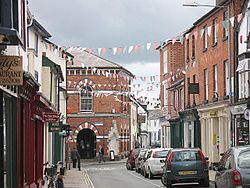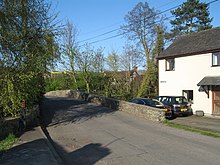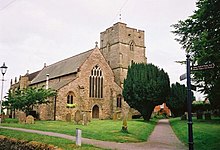Presteigne
| Presteigne Welsh: Llanandras | |
| Radnorshire | |
|---|---|
 Presteigne High Street | |
| Location | |
| Grid reference: | SO315645 |
| Location: | 52°16’28"N, 3°0’19"W |
| Data | |
| Population: | 2,463 (2001) |
| Post town: | Presteigne |
| Postcode: | LD8 |
| Dialling code: | 01544 |
| Local Government | |
| Council: | Powys |
| Parliamentary constituency: |
Brecon & Radnorshire |
Presteigne is the county town of Radnorshire. The parish is within in the Diocese of Hereford. Despite lying on a minor B-road the town, in common with several other towns close to the edge of Wales, has assumed the title "Gateway to Wales".
The town sits on the River Lugg, having nearby towns such as Kington and Knighton as neighbours, as well as surrounding villages like Norton and Stapleton.
Presteigne is considered by Country Life magazine editor Clive Aslet to be one of Britain's top 10 small towns.[1]
Name of the town
The name "Presteigne" is from Old English; preosta tun meaning "priests' town", making Presteigne one of a set along with Kington, Herefordshire and Knighton, Radnorshire.
The Welsh name for the town is Llanandras ("St Andrew's church"). The church is indeed dedicated to St Andrew, and is within the Diocese of Hereford.
History
Overview
The town probably began as a small settlement around a minster church dedicated to St Andrew and at the time of the Domesday Book and formed part of the manor of Humet.
By the mid-12th century the town was known as 'Presthemede' or 'the border meadow of the priests'. A century later, it passed into the control of the Mortimers, powerful Marcher lords, and on their fall passed into the hands of the Crown.
At the end of the 13th century, the majority of the town's inhabitants, mainly English, enjoyed some prosperity but the Black Death and the Glyndŵr rebellion had destroyed this and by the end of the 15th century, the population lived in a struggling village. A significant victory in their rebellion was won by the forces of Owain Glyndŵr nearby at the Battle of Bryn Glas in 1402.
The development of a thriving cloth industry in the Tudor period brought short-lived prosperity, ended by three new epidemics of plague in three successive generations. Thereafter it became a market town and, until the later 16th century, a centre for processing locally grown barley into malt.

The bridge marks the Herefordshire boundary
By the Laws in Wales Acts 1535–1542, Presteigne jointly with New Radnor became the county town of Radnorshire and its administrative and judicial centre, housing the county gaol and the Shire Hall.
By the end of the 19th century administrators had moved off to the nearby, new spa town town, Llandrindod Wells, but the judges still came to Presteigne to hold the Assizes until these were abolished in 1971.
After a period of stagnation in the first half of the 20th century, the town has developed a diverse manufacturing base[2] and has begun to exploit its tourism potential while its environment and the development of its social, cultural and leisure facilities have helped to attract people to settle.[3]
1930s – 1940s
During the 1930s, the Ministry of Labour opened a work camp for long-term unemployed young men. Many of the inmates came from the crisis-hit coal mining, steel and heavy industry communities of South Wales. Presteigne was one of a number of Instructional Centres created by the Ministry, and it also had a satellite camp in Shobdon, Herefordshire. By 1938, the Ministry had 38 Instructional Centres across Britain. The camp was situated in Slough Lane near Hill Farm and is now a small private housing site.
Land owned by Capt Lewis RN, of Clatterbrune House, was used to hold first Italian and then German prisoners of war during the Second World War and is now the home of Presteigne St Andrews Football Club.
Churches

- The parish church is St Andrew, within the Diocese of Hereford in the Church of England and flies the St George banner. Parts of the church are of the Anglo-Saxon period.
The church contains the Presteigne Tapestry, a Flemish tapestry of about 1510, depicting Christ's entry into Jerusalem, one of three versions of the scene. It is believed to be one of only two pre-Reformation tapestries still hanging in a church in Britain. The Tapestry was donated to the church in 1737 and was used as cloth for the communion table until the 19th century; now framed, it can be seen hanging on the north wall of the church.
Sights about the town
Sights about the town include:
- St Andrew's Church
- The Radnorshire Arms hotel, a Jacobean inn.[4]
- The Judge's Lodging, decorated in mid-Victorian style.[5]
Curfew bell
John Beddoes
Henry Edward's Old English Customs: Curious Requests and Charities mentions the bell-ringer appointed by John Beddoes in 1565 to ring a 'day bell' at 8am, and a curfew at 8pm. Beddoes specified that in the event of the custom being abandoned for more than a year, (except in plagues) the funds set aside for this position would revert to his heirs.
Beddoes - a wool merchant - also gave his name to Presteigne's secondary school, John Beddoes School, which he established in 1565, and endowed with land.
A modern curfew idea
The quiet town of Presteigne attracted national attention in 2004 for an unsuccessful campaign by its Mayoress, Peggy Fraser-Scott to enforce a curfew on the town's youth.[6]
Trains
The Kington & Presteigne Railway opened as an extension of the Leominster and Kington Railway on 9 September 1875. The railway line commenced at Titley Junction, passed through Leen farm, to Staunton-on-Arrow, in front of the Rodd farm by way of Corton into Presteigne.[7][8] By 1929 it was possible to join one of the three steam trains a day - each way - and make the 6 hour journey to London.
The passenger service on the line ended in 1951, but a freight service continued to run every other day until the line was finally closed for good in 1961.[9]
Currently, Knighton is the nearest train station.
Art and culture
The town has become a local cultural centre. It hosts 2 indigenous festivals. First, the oddly named Sheep Music Festival dedicated to contemporary music;[10] and the Presteigne Festival of Music and the Arts[11] which casts a broader cultural net. It attracts composers of calibre.
The town has an award-winning museum, the Judges Lodgings.[12]
The Church of St Andrew permanently houses a 16th century Flemish Tapestry.
Presteigne was also host to the World's first competitive electric bicycle race[13] Finally, the town has inspired twelve songs for voice and piano - A Garland for Presteigne[14]
Bibliography
- Field, J. Learning Through Labour: Training, unemployment and the state, 1890-1939, University of Leeds, 1992, ISBN 0-900-960-48-5 (work camps)
- Parker, K. A History of Presteigne (1977) Amazon link
- Parker, K. Radnorshire from Civil War to Restoration: A Study of the County and Its Environs 1640-60 in a Regional Setting (2000) Amazon Link
References
- ↑ Clive Aslet (9 August 2006). "The Daily Telegraph". London. http://www.telegraph.co.uk/property/main.jhtml?xml=/property/2006/08/09/ptop10.xml&page=3. Retrieved 19 February 2007.
- ↑ "Applegate". http://www.applegate.co.uk/indexes/towns/all-presteigne.htm. Retrieved 19 February 2007.
- ↑ Keith Parker. "BBC". http://www.bbc.co.uk/wales/mid/sites/presteigne/pages/keith_parker.shtml. Retrieved 19 February 2007.
- ↑ "hotelSite". http://www.radnorshirearmshotel.com/. Retrieved 1 September 2008.
- ↑ "Official Site". http://www.judgeslodging.org.uk/. Retrieved 19 February 2007.
- ↑ "BBC". BBC News. 22 April 2004. http://news.bbc.co.uk/1/hi/wales/mid/3648967.stm. Retrieved 19 February 2007.
- ↑ "Kington Town Site". Archived from the original on 9 December 2006. http://web.archive.org/web/20061209235930/http://www.kington.org.uk/site/Kington/history.asp. Retrieved 19 February 2007.
- ↑ "Google Mapping - route of the Kington & Presteigne Railway". http://maps.google.com/maps/ms?ie=UTF8&hl=en&t=k&msa=0&msid=106041594637890717105.00044e978df6f588355fe&ll=52.246827,-2.973518&spn=0.068421,0.179901&z=13. Retrieved 1 June 2008.
- ↑ "Herefordshire County Council". http://www.smr.herefordshire.gov.uk/post-mediæval/railways/king_prest.htm. Retrieved 19 February 2007.
- ↑ "Sheep Music". http://www.sheepmusic.info/. Retrieved 19 February 2007.
- ↑ "Presteigne Festival". http://www.presteignefestival.com/. Retrieved 19 February 2007.
- ↑ "The Judges Lodgins". http://www.judgeslodgings.com/. Retrieved 19 February 2007.
- ↑ "The Daily Telegraph". London. 29 April 2006. http://www.telegraph.co.uk/motoring/main.jhtml?xml=/motoring/2006/04/29/mnbatt29.xml. Retrieved 19 February 2007.
- ↑ "Amazon". http://www.amazon.com/dp/B000636WDK. Retrieved 19 February 2007.